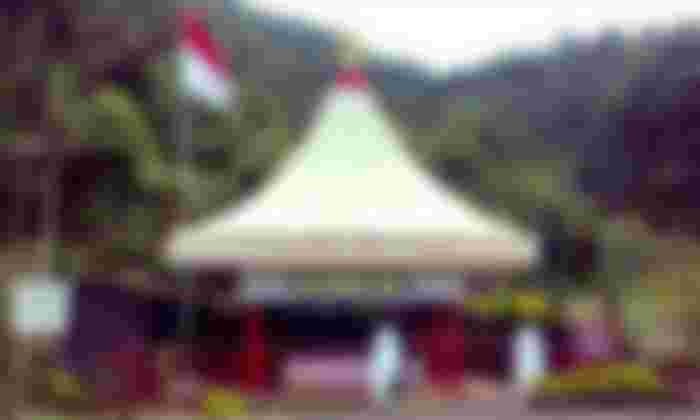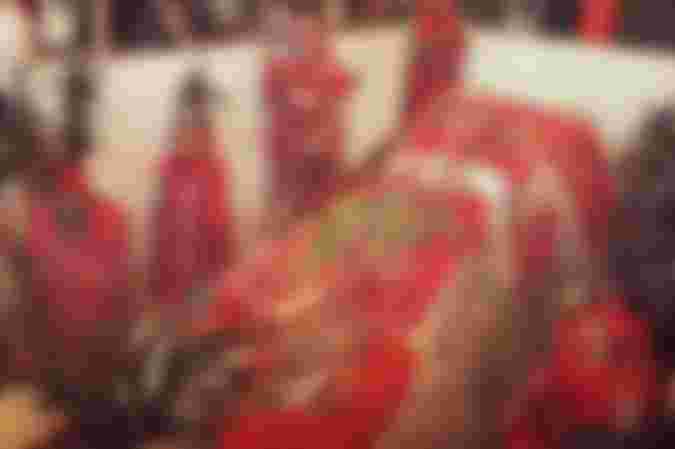Watu Penawetengan: Place of Ritual and Beginning of Faith
This is a continuation of the previous article about the life and beliefs that existed in my area in the past. The story that happened in this story I dug up from several elders who were still alive and my visit to this historical place.
Pinawetengan Stone

If you come to my area then one thing that is important for you to visit is one of the most famous historical destinations in my area. This place has been made a "Cultural Nature Reserve" in my country and one thing you need to know is that this place was the beginning of the formation of my area from generation to generation from the past to the present.
Overall the early life of The history of the descendants of Toar and Lumimuut (my area) continues to grow to meet their initial settlement area is tu'ur intana until a time comes calamities and natural disasters that are a warning that they are have to vacate the tu'ur diamond and find a new land of livelihood from the descendants of Lumimuut. After various obstacles and suffering, they arrived in a hill called tonderukan, from that place is displayed beautiful scenery whose area is very wide and fertile according to the instructions thank you. One side of that section is Mount Soputan (sigh). Soon they will be the leaders of gotong royong to build settlement in a place called Ranolesi. At first the guardians prepared thanksgiving sacrifice ceremony and looking for a place to establish tumotowa namely a stone that became a ritual altar as well as marking the founding of a community.
The custom of the Minahasa people who used the altar in the form of a large stone extends from east to west and when found on it perched birds Manguni, while the surrounding stones are occupied by a black snake then the big rock declared as the great altar. Manguni Bird by Jessy Wenas in his book entitled History & Culture of MINAHASA explains about views and naming of several sub-ethnics in Minahasa, birds manguni is called Ot in Tombulu, Kwoit in Tonsawang and sluggish from the Tondano language, and in general view among the Minahasa people called the Manguni bird (original Minahasa) in scientific language called Ninox Punctulata. In the Minahasa traditional ceremony this bird is called Wara . Im Bengi or signer of the night. Kuouw In Tana (Manado Malay) perched on thickets of different colors and places, yellow reddish (Macropygia Albicapila), Kuouw Randan or Kuouw Red wing and reddish-brown back, yellow-green body they live above all trees. Kuouw Rendem, Kuouw Black, Kouw – kouw live in a tall tree (Eudynamis Honorata), brown back, reddish wings, brown tail, sounds at 02.00 midnight, at 05.00 in the morning starting from a low tone then then higher.
In every sign the Manguni bird gives by voice at night, three times nine or in Minahasa "telu thank you‟. In the context of the sound made by the Manguni bird, there are some signs that can only be heard by indigenous Minahasa people. Tiga means the three forces of God, Nature, and Man. The three themselves are goes to the nine powers, and is multiplied by nine times, which becomes Minahasa holy numbers. By hearing the sound of the Manguni bird, you can understand the meaning of three times nine whistles.
Tonaas wangko is the great leader, after choosing the altar will perform traditional ceremonies with burnt offerings that are very much in the form of a number of animals that were hunted by the waranei and at this ceremony were given the mandate that is poured or known today as the Watu Pinawetengan mandate which contains: this land is our common property according to the instructions of the manguni.
Distribute this land, encroach on new frontiers of livelihoods, O worker. Master and defend the territory, O knights, so that our descendants can live and give life in the local language Akad se tu'us tumou o tomowtou.

Watu Pinawetengan eventually became the main altar because of this place is negotiated and mandated territorial divisions settlement of the descendants of Toar and Lumimuut. Next Watu Pinawetengan become a meeting place for the leaders of the children of the Minahasa ethnic group every time you face a big problem and need reaffirmation every union (maesaan). But then, as the years went by, Watu Pinawetengan was lost in time. Even on the surface of the area traditional leaders from generation to generation always come to carry out The summoning ceremony for the stone was only carried out in 1888. According to the results analysis of J.A.T Schwarz and J.G.F Riedel who are sons of German missionaries sent to Minahasa, based on a number of spoken stories and oral literature inherited from parents. On this day when we gather here each of us lives up to the values and spirit of unity that are constant and increasingly needed in this day and age.
The development of time that continues to roll, stops existence Minahasa ethnic Christianity knows today's Christianity like Christianity Protestant, Catholic, Muslim, Hindu, Buddhist and so on. The majority of people Minahasa embraced Protestant Christianity as Christianity who first entered the land of Minahasa. From that to the end The Minahasa community also founded the Minahasa people's Church which was named Evangelical Christian Church in Minahasa (GMIM). GMIM itself strengthens its identity with the church logo, namely the image of the Manguni bird. Determination The Manguni Bird as the Symbol of GMIM is based on the results of the trial complete body of GMIM workers in early 1975. The Manguni bird in explanation of the previous meaning, The bird who is the bearer of good news in among the Minahasa people, giving news or signs by making a "hoot" sound. nine times, and it is believed to be a good omen for the Minahasa people. The Manguni bird is considered a sacred bird because The Manguni bird is believed to be an intermediary for the Minahasa people with Creator. A GMIM Pastor, namely Pdt. Prof. Dr. W.A. Roero too said "The Manguni bird is more sensitive to interacting with the natural environment and by therefore more skilled in and understanding nature, he is more sensitive to disruption of climate change, natural phenomena more specifically disasters, as is the case today.” There are many positive things about understanding over the Manguni Bird itself and when the Manguni bird becomes a Symbol GMIM has the meaning of the Church's Vision and Mission as a statement of Faith in Islam Minahasa context in which loyalty and adherence are depicted listen to God's Word, see critically the development of the world and needs of service to humans and ready to preach the gospel to creatures, from the Minahasa Earth to all corners of the archipelago to to all corners of the world It can be directly said that, in fact, society The Minahasa masses now believe in the beliefs of the Christian faith or other Christianity held by the community. It can be happened but, in fact there are still people who do worship or Christian rituals or Minahasa tribal beliefs for that matter campetan at Watu Pinawetengan Minahasa. If explored more deeply, the community directly who does this negotiates with their Christian identity.
Kampetan Ritual

Kampetan rituals have the aim of reviving memories past by Tonaas and other ritual performers against the ancestors they. However, this ritual is also often used as the opening of all types of rituals that exist in Minahasa. The perpetrator of this kampetan ritual, is none other than is a Minahasa community who is Christian and also Christian other Christians in Minahasa. According to the information that the authors get based on field observations and several interviews, emphasized that this ritual can indeed be carried out by the people of all subethnics are also christian in Minahasa. The Kampetan ritual has another name that is better known to the public formerly known as the Canal. It's the same as that campan the ritual leader in this case Tonaas will be transfigured by a spirit ancestors. Transfiguration like this only happened to Tonaas, not to other ritual performers. This is because Tonaas is someone who entrusted or crowned as a leader in the village or Wanua. The process of determining Tonaas is selected or determined through natural phenomena that appears in the family in question, for example the wind spins in front of the house even to the point of a fire indicating that there is one member The family is the media. But basically selected by democracy with the criteria that it has advantages in terms of strength, resources, human resources and other personality traits. Tonaas not only only in the village but in ancient times there was Tonaas who worked when hunting with the community. Tonaas as a conferred title by society in general, after being reviewed from their personality, this is who can be said as a mediator or also called the pakampetan or canal. This is the reason for the naming of this ritual as kampetan or continuation. The procedure for carrying out this kampetan ritual is very clear.
Previously, the performers of the ritual prepared everything needed in the rituals of their good selves namely society as well as tonaas. After finishing preparing, tonaas and the performers of the ritual who will later will help tonaas, changing their clothes with clothes and attributes become all red. This outfit is almost similar to the clothes used by traditional dancers kababaran from Minahasa. Starting from the red headband and vest and red pants. After that, they prepare offerings or The offerings in this case are in the form of wrapped rice, satay, captikus or saguer stuffed in bamboo (kower/takoi), tabako (cigarettes) and eggs each amounted to nine pieces. Likewise they prepare the equipment that will be placed on a stone including a red cloth to cover part of the stone body, kris wrapped in red cloth, the bible and other appropriate objects at the request of the community. Examples of other objects such as accessories or personal belongings to be prayed for. Talking about offerings, people Minahasa who no longer perform this ritual argue that, giving offerings is the same as worshiping idols. But, for people who still perform this ritual are also cultural observers explained that, the giving of this offering is a form of gratitude for the efforts made has been accepted by the community and under as a form of offering and tribute to Opo Wananatas. Rituals in ancient times gave offerings changed their crops or livestock. However, along with the rapid development of the times, people agree to replace it with processed products which has been made with the existing considerations. Wrapped rice is typical rice
Minahasa people wrapped in leaves, captikus or saguer is a drink Typical of the Minahasa people are also the most popular produce of the community. Tabako or cigarettes are one of the offerings because they used to be tabako too become the livelihood of the community before the emergence of cigarettes now more . But in the ritual, if the perpetrator does not have time to make tabako, it can be replaced with cigarettes. It's the same with eggs, as a substitute for chickens or livestock, but it is possible if people want to offer animals in this case the chicken then it is not a problem. Likewise, things symbolic objects or attributes used in this ritual are described as the link between man and God. Ritual performers set an example on the existence of one of the Christians in Minahasa, namely Christianity. red cloth or a red dress is also a kris, it's the same with the use of a priest's clothes or stole in worship. So there is no negative element in this ritual attribute.
Starting the ritual, the performers walk while pounding The feet circle the rock nine times. This they do as a form of respect for the place is also the ancestors or in the local language Sumigi. Nine rounds around the stone as a symbol of the 9 sub-ethnics in Minahasa. After surrounding the stone, the ritual performers enter the area stone with a standing position on the right and left while tonaas take a position behind the stone, offerings are placed in front of the stone and the attributes another on the rock. After everything is ready, tonaas continues the ritual with the mengalei procession which means asking Opo Wananatas with how to stomp your feet 3 times and raise your hands. Next, tonaas or people who perform rituals open the rituals by praying and singing songs Opo Wananatas together. Opo Wananatas song, is a must sung in the implementation of the kampetan ritual. Uniquely, this song is in implementation of Christian worship practices is also often sung when in worship using the liturgical system of the local language. This is one of the the similarity of the liturgical order of the song is good in ancient cultural practices too contemporary Christianity.
The lyrics of the song Opo Wananatas which are sung together are as follows:(in my local language)
“Opo wana natas'se Tembone se wandering around Tembone se wandering Ngale Pakatuan Pakalawiren Kuramo kalalei repeat of coursemo kalalei untana Kuramo kalalei camel of coursemo kalalei ta in tou. Nikita in tou karia Enimpa uman uman enimpa uman karia Wia si Opo wananatas Si Opo wana natas Sia the eye or ampeleng Sia si Mamuali wia mbawoin ampleng tana."
It means : Lord God above, look at us who live in this world, look at us who live in this world. Bless with long life and prosperity. As the sky is, so is it with the ground, as it is land, as well as us people man. We humans are just just adjust, just adjust with the will of God above. Lord Allah above, he alone know what's best for us, he only knows what's best for us, what will happen on earth we are beloved.
After singing together, one of the performers of the ritual in this case who help tonaas, pray to Opo Wananatas in Indonesian. Contents the prayer is about confession of sin and supplication to God. Quoted from the implementation of the campetan ritual, the contents of the prayer are as follows: Father, in our life everything is yours. eye testimony our bodies see, the existence of each other's life realize that we don't have any power humanly.
Currently seeing the various events experienced in the testimony of life personal and family often feel inferior, feel sorry with what is experienced in the journey of life but, we believe that the greatness of God is so great that always visits our lives, then we witness personally that God always side with the right people, so we always admit that God guides our lives even though our paths often slipping into things that are not right. But by seeing the good Lord in our life, there is actually a shame to come to God because God is so good who teaches us always to realize that God will continue to care for us and give us grace. We are gathered in this place, longing for help, humble yourself, unite hearts, to come tell life us with various conflicts and problems because we admit only to God we give our full hope. don't we are humiliated by powers that do not want us to exist at the moment. Truly in front of you we need you to ward off all things that are not true. Right now there are also some brothers we who are sick and need help, their helplessness at this time makes them strengthen their faith even more to you of them (the prayer leader mentions the names of people). Have mercy on them, O Lord. This is our request Lord, let us always find God working for us, After praying and offering praise, tonaas was transfigured by ancestral spirits and this is what is called kampetan or pass. Ancestor who It is believed that entering the body of tonaas came from the great ancestors of people Minahasa or also called opo-opo.
After undergoing a transfiguration that, starting tonaas speaking giving advice in the local language Minahasa. In this ritual, tonaas is accompanied by his understanding companion Minahasa regional language to translate the meaning of tonaas utterances. When the ancestral spirit has entered the tonaas, then the translator who is in beside tonaas said hello and asked who the spirit that came was. Because there are also evil spirits who often enter tonaas who want to cheat. In order to know whether the spirit is an impostor or not, then it must asked what his name was and where the spirit lived. If the spirit is not answer, it means he does not know and the spirit is a deceiver. The ancestral spirit who believed by followers of Minahasa Christianity are spirits of good manners, including when it comes through tonaas. So when a spirit has entered in tonaas and he spoke impolitely, it means it's an evil spirit that want to cheat. When the translator greets, he gives tabako already made or cigarettes for the spirit. After that the ancestral spirit who coming via tonaas will start communicating with the translator. Each person those present in this ritual can ask the spirit. What kind of question is that only can be put forward, and will be answered by the spirit through tonaas. For example question about building a house, is it good to build a house on the spot certain.
Ritual performers who are sick, under close to tonaas to be treated. Tonaas took the tawaang that had been provided and then threw it the body of a person who is sick. Next thing, sick people just need to say where the disease is and the spirit that goes into tonaas will hold the part, while saying a prayer. If needed, then the spirit will suggest to consume natural ingredients or also do something ordered by the ancestral spirit as a support get healing. It should be noted that, there is more than one spirit that can come through tonaas when performing rituals. The arrival of these spirits depends on the spirit itself. Tonaas cannot command or choose spirits which one is coming. These spirits include, Opo Soputan, Pour, Madam, Wowo‟, Lokon, and others. The duration of the arrival of these spirits nor is it determined by the tonaas, but is determined by these spirits themselves. These spirits come alternately through tonaas. If there is no longer a spirit that come, then the people who are beside tonaas will hold their bodies and stroking tonaas shoulder until he returned to normal.
Previously, the thing that tonaas did earlier took out the inner spirit his body, he shook hands with everyone present while give advice according to what each person is experiencing without them saying it. After that tonaas will rearrange the ingredients the materials used in the ritual earlier and the ritual process is complete.
<<=>>



Wow this is mind blowin